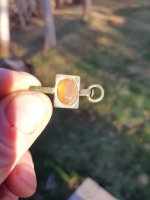- Feb 2, 2013
- 1,421
- 1,986
- Detector(s) used
- Many
- Primary Interest:
- All Treasure Hunting
Archaeological Resources Protection Act of 1979
From Wikipedia, the free encyclopedia
Jump to navigationJump to searchThe Archaeological Resources Protection Act of 1979 (Pub.L. 96—95 as amended, 93 Stat. 721, codified at 16 U.S.C. §§ 470aa—470mm), also referred to as ARPA, is a federal law of the United States passed in 1979 and amended in 1988. It governs the excavation of archaeological sites on federal and Indian lands in the United States, and the removal and disposition of archaeological collections from those sites.[SUP][1][/SUP]
ARPA was launched in the 1970s after the Antiquities Act of 1906 was declared “unconstitutionally vague”. The Antiquities Act was unable to protect historical sites from criminal looting. Several attempts by the federal land-managing agencies and prosecutors to use this act resulted in judges saying that it was unconstitutionally vague making it unenforceable.(Harmon 172) ARPA regulates access to archaeological resources on federal and Indian lands. Uniform regulations were issued by the Department of the Interior, the Department of Agriculture, the Tennessee Valley Authority, and the Department of Defense. Archaeological resources are defined as "Any material remains of human life or activities which are at least 100 years of age, and which are archaeological interest."(King 252) Also defined is "Of archaeological interest" which is "Capable of providing scientific or humanistic understandings of past human behavior, cultural adaption, and related topics."(King 252) ARPA forbids anyone from excavating or removing archaeological resources from federal or Indian land without a permit from a land managing agency. ARPA also forbids any sales, purchase, exchange, transport, or receipt. Those who violate can face substantial fines and even a jail sentence if convicted. They will also confiscate any object that has been declared as an archaeological resource.
See also[edit]
References[edit]
From Wikipedia, the free encyclopedia
Jump to navigationJump to searchThe Archaeological Resources Protection Act of 1979 (Pub.L. 96—95 as amended, 93 Stat. 721, codified at 16 U.S.C. §§ 470aa—470mm), also referred to as ARPA, is a federal law of the United States passed in 1979 and amended in 1988. It governs the excavation of archaeological sites on federal and Indian lands in the United States, and the removal and disposition of archaeological collections from those sites.[SUP][1][/SUP]
ARPA was launched in the 1970s after the Antiquities Act of 1906 was declared “unconstitutionally vague”. The Antiquities Act was unable to protect historical sites from criminal looting. Several attempts by the federal land-managing agencies and prosecutors to use this act resulted in judges saying that it was unconstitutionally vague making it unenforceable.(Harmon 172) ARPA regulates access to archaeological resources on federal and Indian lands. Uniform regulations were issued by the Department of the Interior, the Department of Agriculture, the Tennessee Valley Authority, and the Department of Defense. Archaeological resources are defined as "Any material remains of human life or activities which are at least 100 years of age, and which are archaeological interest."(King 252) Also defined is "Of archaeological interest" which is "Capable of providing scientific or humanistic understandings of past human behavior, cultural adaption, and related topics."(King 252) ARPA forbids anyone from excavating or removing archaeological resources from federal or Indian land without a permit from a land managing agency. ARPA also forbids any sales, purchase, exchange, transport, or receipt. Those who violate can face substantial fines and even a jail sentence if convicted. They will also confiscate any object that has been declared as an archaeological resource.
See also[edit]
References[edit]
- ^ Seidemann, Ryan M. (November 9, 2006). "The Reason Behind the Rules: The Archaeological Resources Protection Act of 1979 and Scientific Study". bepress Legal Series, Working Paper 1874. Berkeley Electronic Press.
- Harmon, David, Francis P. McManamon, and Dwight T. Pitcaithley. The Antiquities Act: A Century of American Archaeology, Historic Preservation, and Nature Conservation. Tucson: U of Arizona, 2006. Print.
- King, Thomas F. Cultural Resource Laws and Practice: An Introductory Guide. Walnut Creek, CA: AltaMira, 1998. Print.
- Annotated text of ARPA from the National Park Service
- National Park Service technical bulletin on application of ARPA






